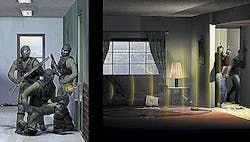Time Domain through-wall surveillance radar aids in counter-terrorism and urban warfare
By John McHale
HUNTSVILLE, Ala. — Engineers at Time Domain Corp. in Huntsville, Ala., are developing a handheld, through-wall surveillance radar device with an ultra wideband signal called SoldierVision that can help military and counter-terrorism personnel by providing accurate information about the enemy's location, especially in an urban or underground environment.
Time Domain officials are doing the work under contract to the U.S. Army Night Vision Laboratory at Fort Belvoir, Va., under the U.S. Department of Defense Advanced Concept Technology Demonstrator program.
"The military has been looking at several technologies for through-wall surveillance," says Will Webb, senior vice president for the Government-Defense sector at Time Domain. The chief advantage of an ultra wideband signal is its ability "to provide the best combination of clarity, resolution, and range available," Webb says. "That is critical for warfighters, particularly in urban warfare."
SoldierVision could help reduce battle casualties by acting as a soldier's surveillance tool, help police during hostage situations, and possibly even find terrorists hidden in caves, says Glenn Morris, director of radar operations at Time Domain.
The device's signal penetrates common building materials such as reinforced concrete, concrete block, sheetrock, brick, wood, plaster, tile, and fiberglass. In common with all radio frequency technologies, the signal cannot penetrate solid metal or metal-coated objects.
The soldier operating the device will see movement on the other side of a wall as a red blob on a 5 and a half-inch, color liquid-crystal display, Morris says. Time Domain engineers are improving the blob's resolution so it can detect handheld weapons, he adds.
Time Domain engineers say they plan to leverage technology they developed previously for a through-wall radar detector they developed for police departments called RadarVision 2000.
RadarVision2000 and SoldierVision take advantage of Time Domain's PulsON wireless technology, which sends millions of radar pulses per second, and is capable of penetrating several different walls at a current maximum range of 33 feet, or 10 meters, Morris says.
"Ultra wideband radar has been around for a long time, but we are able to do it a very low power," he says. The device generates 10,000 times less power than a cell phone, Morris adds. "We're also able to time pulses accurately down to three trillionths of a second," he says.
The technology is illegal for most users, Morris says, because it can interfere with radio frequency communications. However, leaders of the Federal Communications Commission in Washington have given Time Domain a waiver to provide a limited number of their RadarVision2000 products to Law Enforcement, he continues. The military is not as concerned with FCC regulations, Morris adds.
Even still, RadarVision2000 and SoldierVision have little change of interfering with other radio signals because they operate at such lower power and at such a low frequency of 2 gigahertz, plus or minus 1 gigahertz, Morris says.
In fact, there is a greater chance that other RF devices will interfere with Time Domain's device, a problem Time Domain engineers have solved with algorithms that filter out any interfering signals similar to the way sonar filters out noise, he explains.
SoldierVision uses an off-the-shelf processor similar to a Pentium 4, Morris says. He declined to comment on the name of the supplier due to contractual obligations. However, the key components of the SoldierVision radar on a time chip and a correlation chip, both designed by Time Domain and manufactured by IBM, Morris says.
The time chip, a silicon-germanium application-specific integrated circuit, enables SoldierVision to send and receive its pulses accurately down to three trillionths of a second, Morris says. Then the correlation chip gathers the millions of pulses into a waveform for analysis, he explains.
SoldierVision will weigh approximately 10 pounds and is battery-powered with a two-hour rechargeable life, Morris says. Company officials say they expect SoldierVision to co-exist with other military equipment, and be ruggedized for harsh battle conditions.
The 15-month contract with the Army Night Vision Lab is part of the military's continuing effort to implement technologies for Military Operations in Urban Terrain (MOUT), which many planners see as the dangerous and challenging battlefield of the future, Time Domain officials say.
For more information on Time Domain contact the company by phone at 256-922-9229, by fax at 256-922-0387, by mail at Cummings Research Park, 7057 Old Madison Pike, Huntsville, Ala. 35806, by e-mail at [email protected], or on the World Wide Web at http://www. timedomain.com.

